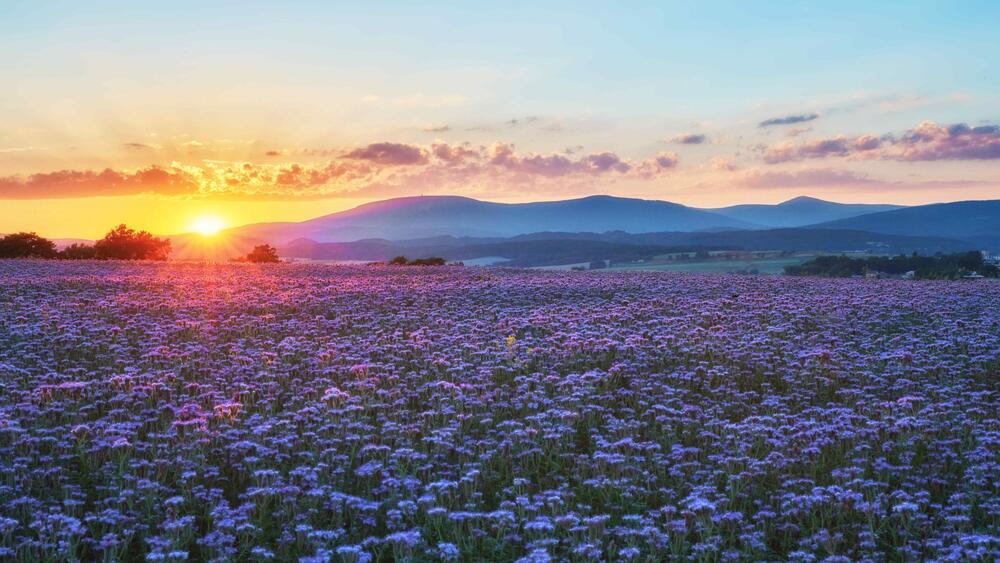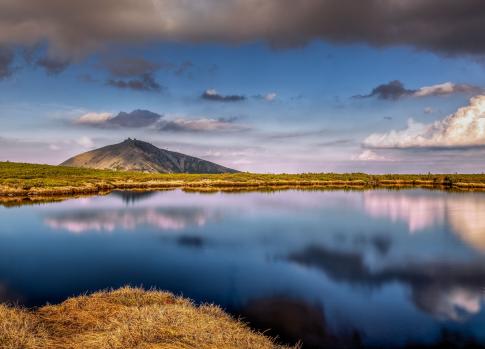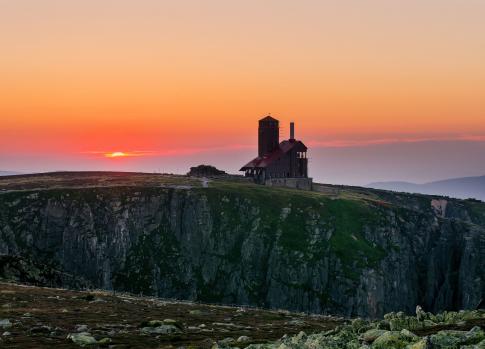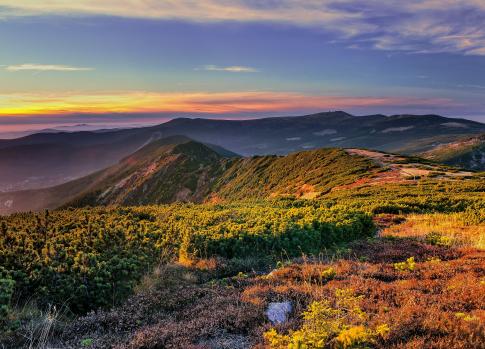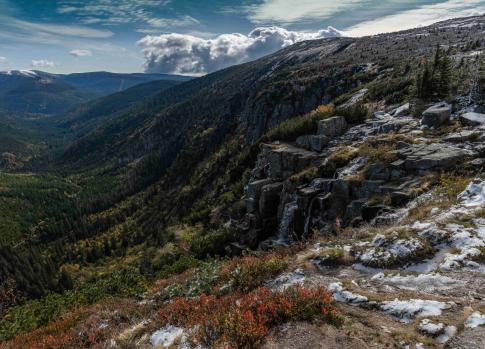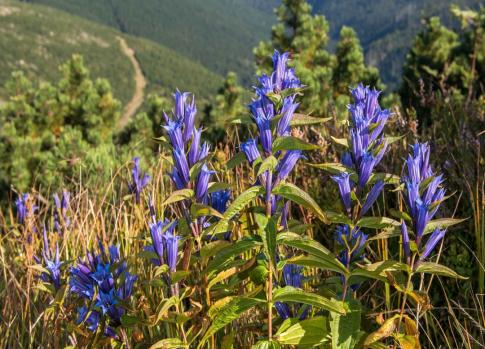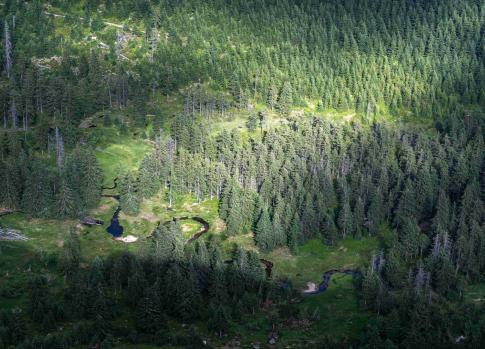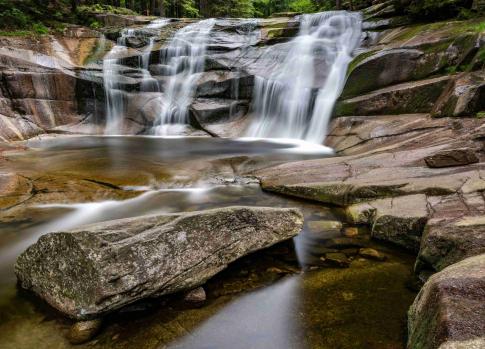Co je to klidové území a jak se v něm chovat?
Klidové území pokrývá nejcennější partie národního parku, které tedy vyžadují nejpřísnější stupeň ochrany. Je to asi 20 procent z celkové rozlohy KRNAP. Že vstupujete do takové oblasti poznáte podle značení v terénu. U cesty vás na to upozorní zelená smaltové cedule na dřevěném sloupku. V terénu to je pak pásové značení je umístěno na stromech a má podobu červených pruhů. Horní je po celém obvodu kmene a spodní jen do poloviny. Vidíte-li dva pruhy, stojíte mimo klidové území, vidíte-li jeden, ocitli jste se v klidové zóně.
V klidovém území je nezbytné dodržovat především základní pravidlo – zůstaňte na cestě!
Co dělat při setkání s vlkem?
Vlk je sice divoká šelma, na rozdíl od medvěda, lva, či pumy, je však před člověkem plachý. Straní se značených cest a na nich ho tedy pravděpodobně nepotkáte. Stát se to může v lese mimo značené cesty. Ani tehdy není panika na místě. Stačí dát vlkovi čas a prostor k ústupu. Mladí jedinci mohou být zvědaví. Zaplašíte je silným hlasem nebo hlukem. Rizikovým faktorem může být přítomnost vašeho psa. Mějte ho tedy pro jistotu na vodítku. Vlk by ho mohl v lese vnímat jako konkurenci a případný střet by pro pejska nejspíše nedopadl dobře.
Jak tedy správně postupovat při setkání s vlkem?
- Nepřibližujte se, vlka nepronásledujte.
- Vlka nikdy nelákejte na potravu a nekrmte.
- Pokud se nevzdaluje, snažte se o klidný ústup.
- Couvejte, neobracejte se k němu zády, neutíkejte.
- Pokud se k vám vlk přibližuje, pokračujte v ústupu, dělejte hluk (zpívejte, tleskejte, křičte).
Info
Každé setkání s vlkem je skvělé nahlásit Správě KRNAP, a to na mail kmikslova@krnap.cz, nebo tel. 731 533 895. Důležité informace jsou čas a místo setkání, případně i fotografie či video.
Proč se v Krkonošském národním parku nesmí jezdit na kole všude?
Protože zákon o ochraně přírody a krajiny říká, že na kolech nelze v národním parku jezdit nikde jinde než po vyhrazených trasách. Správa KRNAP proto vyhradila více než 400 km oficiálních cyklotras. Další stovky tras čekají mimo území parku, například v podhůří.
Proč není regulováno množství lidí na Sněžce?
Protože to neumožňuje česká legislativa. Navíc Sněžka je přeshraniční hora a na její návštěvnost má zásadní vliv turismus z polské strany. Lanovka z Pece pod Sněžkou má kapacitu omezenou a za jeden den vyveze nahoru stále stejný počet návštěvníků, tedy „pouhých“ 2.500 návštěvníků. Lanovka na Kopu z polského Karpacze limitovaná není, a tak se při pěkném letní dni na Sněžce vystřídá i 10.000 turistů.
Jak je to s nocováním v útulnách a přístřešcích?
Je to legální, ale není to dobře, protože k tomuto účelu nejsou primárně určeny. Útulny a přístřešky jsou na horách proto, aby v nich turisté našli suché a bezpečné útočiště při nepříznivém počasí. Slouží k přečkání akutní nepohody. Na nocležníky nejsou vybaveny.
Více o útulnách
Kde je tedy možné na hřebenech při vícedenních přechodech přespat?
Na území národního parku není povoleno táboření. Pokud se člověk ocitne v akutní nouzi, je možné bivakovat na značených cestách. Krkonoše však mají velmi širokou síť horských bud a chalup, využijte jejich služby.
Proč nejsou podél horských cest odpadkové koše?
Zcela záměrně. Každodenní vyvážení odpadu je finančně nákladné, navíc by znamenalo pohyb servisních vozů po cestách, které využívají i turisté a cyklisté. Kdyby se koše nevyvážely denně, zvěř by je roztahala do širokého okolí. Proto je v Krkonošském národním parku, stejně jako v ve většině národních parků Evropy, apelováno na dodržování zásady – co si do přírody přinesu, to si taky odnesu.
Je pravda, že se v polském národním parku platí vstupné?
Ano. Vstupné ve výši zhruba 10 Zł je možné uhradit předem online (https://kpn.gov.pl/bilety), nebo díky QR kódům umístěným na cedulích v terénu. Zpoplatněn není vstup na hřebenovou cestu česko-polského přátelství.
Je možné po KRNAP jezdit autem?
Vjezd motorových vozidel na území Krkonošského národního parku je zákonem regulován. Kromě bezpečnostních složek a správců území mají právo vjezdu například majitelé, obyvatelé a nájemci objektů, podnikatelé a firmy, pokud mají v území provozovnu nebo zásobování. Pokud se chystáte k pobytu v chráněném území, kontaktujte ubytovatele, poradí vám, co a jak.
Jak zjistím, na kterých cestách je aktuálně omezená průchodnost?
Na mapovém portálu Správy KRNAP najdete všechny aktuální uzavírky či omezení průchodnosti tras. Ať už z důvodu ochrany přírody či oprav. Stejně tak omezení uvidíte třeba na mapy.cz.
Mapový portál KRNAP











